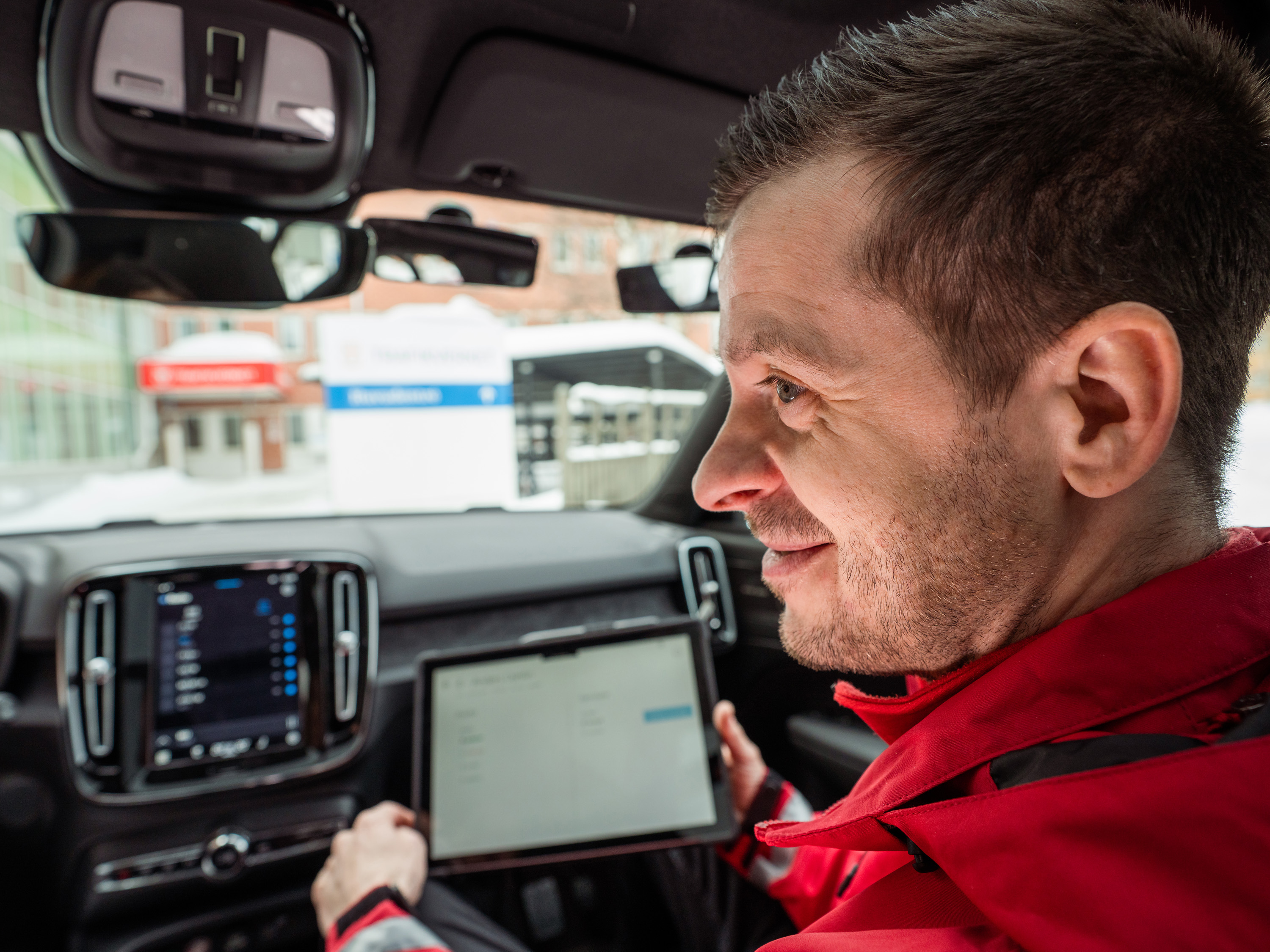The theory test and the practical driving test
Customer service for driving licences
For questions regarding driving tests and photography. Opening hours:
Monday - Wednesday, Friday 8.00 am - 4.15 pm, Thursday 8.45 am - 4.00 pm
Phone number +46 (0)771 171819 (open all hours if you need to cancel your appointment)
Do you have a question or do you want to leave an opinion?
Please write to us by filling in this form (form in Swedish)
Driving test offices
You can find our driving test offices on this page (page in Swedish)
The driving licence test consist of two different tests. First, you take a theory test that you must pass before you can take the driving test.
In order to obtain a Swedish driving licence, you will need to take a knowledge theory test and a practical driving test. During the tests, you must prove that you have the required theoretical knowledge you need to be a safe driver.
Prior to your theory test
Everyone must have their photo taken in conjunction with their first theory test. Therefore, you should make sure to arrive well in advance of your test.Remember to bring valid proof of identity.
More about identification requirement
Having your photograph taken for your driving licence is a requirement for being allowed to take the test. This also applies to those who already have a driving licence and are taking a test to be approved for a new licence category.
The theory test for B licence
The test consists of 70 questions and you must answer 52 questions correctly to pass the test. During the test, you are able to listen to the questions (in Swedish), if you want to. You will have 50 minutes to complete the test.

The theory test measures whether you have the necessary theoretical knowledge to be a safe, eco-friendly driver.
We will not tolerate cheating
Before starting the theory test, you must promise that you will take it without using any unauthorised tools or attempting to cheat in any other way.
This is what will happen if you cheat:
- You will be reported to the police for making a false statement.
- You will be banned from taking your test for one or two years.
- Your test will be discontinued and declared null and void.
- If you have another test booked, that test will be cancelled.
- You will not be able to book more tests yourself.
- Mobile phones must be completely switched off in the test hall.
After the test
You will be informed immediately whether you have passed or failed the theory test. We will send the result to your email address.
Vehicle knowledge and manoeuvring, for example:
- How the vehicle works and how the road conditions affect its driving characteristics.
- Which risks may arise if the vehicle fails to function properly.
- The link between driving technique and the vehicle’s behaviour.
The environment, for example:
- How the means of transport you choose can affect the environment.
- How to drive the vehicle in a safe, eco-friendly manner.
Road safety, for example:
- What it means to demonstrate good judgement when interacting with other road users.
- How to adapt your speed, distance and other driving parameters to various situations.
- How different road conditions and environments affect driver behaviour and road safety.
Rules of the road, for example:
- Road signs, road markings, speed limits, meeting oncoming traffic and overtaking, cargo, passengers and obligations to other road users.
Actions and reactions, for example:
- How medicines, alcohol, other drugs, stress and tiredness can affect driver behaviour.
- How driving at various times of day can affect driver behaviour and road safety.
- How peer pressure can affect driver behaviour and road safety.
The driving test for B licence
The driving test begins with an explanation of the procedure and what the examiner will be assessing. If you do not understand Swedish, you are able to watch a video at the start of your test. You can also see the video here before you arrive to your driving test.
The driving test consists of:
- a safety inspection.
- driving.
First, you will be asked to perform a safety inspection. After that, you drive for a minimum of 25 minutes in a variety of road conditions; for example, urban and rural. The examiner will give you clear instructions on which route to follow. If a dangerous situation arises in which the examiner is required to intervene, you are still regarded as the driver of the vehicle and remain liable if something happens during the test.

When taking your driving test you will be required to prove that you can independently apply your theoretical knowledge to safe driving practices. In the test, you are assessed based on a number of areas of competence.
The examiner will inform you immediately after the driving test whether you have passed or not. The result will be sent to your email address.
Vehicle knowledge
- You should be able to perform a safety inspection of the vehicle – for example, by checking the lights, tyres and oil.
- You will naturally need to demonstrate an understanding of the risks that can arise if the vehicle does not function properly.
Manoeuvring
- You must be able to manoeuvre the vehicle; for example, through the correct use of the pedals.
- You must be able to control the vehicle both when driving.
straight ahead and when turning on bends and corners. - You must be able to reverse and park in a routine manner.
- You must be able to safely operate the controls while driving; for example, adjust the heating and operate the windscreen wipers.
Eco-friendly driving
- You must be able to demonstrate good planning and foresight in your driving.
- You must be able to select the most appropriate gear for both traffic safety and the environment.
Rules of the road
- You must be able to demonstrate familiarity with the rules of the road and comply with them in a routine manner that allows for functioning interaction with other road users.
Road safety and behaviour
- While driving, you must be aware of your surroundings and adapt your driving accordingly.
- You must know where, when and how you should be looking in different situations.
- You must be able to identify and understand the risks in traffic and be able to plan your driving so that you are prepared to react when the situation demands it.
- You must adapt your speed to the current visibility, road conditions and situation.
- You must position the vehicle clearly on the road, for example, when turning or changing lane.
- You must drive within safety margins, for example, by adapting your distance from other road users and stationary vehicles.
- You must use your indicators in good time to show where you are going.
Practical driving tests in automatic transmission vehicles
If you are taking a practical driving test in an automatic transmission vehicle, the driving licence will be issued with a restriction stating that you are only allowed to drive vehicles with an automatic transmission.
In order to remove this restriction, you will need to complete a practical driving test in a vehicle with a manual transmission.